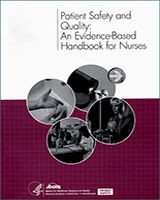Table 2
National Pressure Ulcer Staging System
| Pressure Ulcer Stage | Previous NPUAP Staging Definitions | 2007 NPUAP Definitions | 2007 NPUAP Descriptions to Accompany Revised Definitions | |
|---|---|---|---|---|
| Deep Tissue Injury | A pressure-related injury to subcutaneous tissues under intact skin. Initially, these lesions have the appearance of a deep bruise, and they may herald the subsequent development of a Stage III–IV pressure ulcer, even with optimal treatment. | Purple or maroon localized area of discolored intact skin or blood-filled blister due to damage of underlying soft tissue from pressure and/or shear. |
| |
| Stage I | An observable pressure-related alteration of intact skin whose indicators as compared to an adjacent or opposite area on the body may include changes in one or more of the following parameters: skin temperature (warmth or coolness), tissue consistency (firm or boggy feel), sensation (pain, itching), and/or a defined area of persistent redness in lightly pigmented skin; in darker skin tones, the ulcer may appear with persistent red, blue, or purple hues. | Intact skin with nonblanchable redness of a localized area, usually over a bony prominence. |
| |
| Stage II | Partial thickness skin loss involving the epidermis and/or dermis. The ulcer is superficial and presents clinically as an abrasion, blister, or shallow crater. | Partial thickness loss of dermis presenting as a shallow open ulcer with a red, pink wound bed without slough. May also present as an intact or open/ruptured serum-filled blister. | Presents as a shiny or dry shallow ulcer without slough or bruising. This stage should not be used to describe skin tears, tape burns, perineal dermatitis, maceration, or excoriation. | |
| Stage III | Full thickness skin loss involving damage or necrosis of subcutaneous tissue that may extend down to, but not through, underlying fascia. The ulcer presents clinically as a deep crater with or without undermining of adjacent tissue. | Full thickness tissue loss. Subcutaneous fat may be visible, but bone, tendon, or muscle are not exposed. Slough may be present but does not obscure the depth of tissue loss. May include undermining and tunneling. |
| |
| Stage IV | Full thickness skin loss with extensive destruction; tissue necrosis; or damage to muscle, bone, or supporting structure (such as tendon, or joint capsule). | Full thickness tissue loss with exposed bone, tendon, or muscle. Slough or eschar may be present on some parts of the wound bed. Often includes undermining and tunneling. |
| |
| Unstagable | Full thickness tissue loss in which actual depth of the ulcer is completely obscured by slough (yellow, tan, gray, green, or brown) and/or eschar (tan, brown, or black) in the wound bed. | Until enough slough and/or eschar is removed to expose the base of the wound, the true depth, and therefore stage, cannot be determined. Stable (dry, or adherent, intact without erythema or fluctuance) eschar on the heels serves as the “the body’s natural (biological) cover” and should not be removed. | ||
- ©
2007 NPUAP
- Review Dressing Materials for the Treatment of Pressure Ulcers in Patients in Long-Term Care Facilities: A Review of the Comparative Clinical Effectiveness and Guidelines[ 2013]Review Dressing Materials for the Treatment of Pressure Ulcers in Patients in Long-Term Care Facilities: A Review of the Comparative Clinical Effectiveness and Guidelines. 2013 Nov 18
- Review Systematic reviews of wound care management: (3) antimicrobial agents for chronic wounds; (4) diabetic foot ulceration.[Health Technol Assess. 2000]Review Systematic reviews of wound care management: (3) antimicrobial agents for chronic wounds; (4) diabetic foot ulceration.O'Meara S, Cullum N, Majid M, Sheldon T. Health Technol Assess. 2000; 4(21):1-237.
- Review Are pressure redistribution surfaces or heel protection devices effective for preventing heel pressure ulcers?[J Wound Ostomy Continence Nurs...]Review Are pressure redistribution surfaces or heel protection devices effective for preventing heel pressure ulcers?Junkin J, Gray M. J Wound Ostomy Continence Nurs. 2009 Nov-Dec; 36(6):602-8.
- Tracking quality over time: what do pressure ulcer data show?[Int J Qual Health Care. 2008]Tracking quality over time: what do pressure ulcer data show?Gunningberg L, Stotts NA. Int J Qual Health Care. 2008 Aug; 20(4):246-53. Epub 2008 Apr 6.
- Treatment of pressure ulcers: results of a study comparing evidence and practice.[Ostomy Wound Manage. 2006]Treatment of pressure ulcers: results of a study comparing evidence and practice.Helberg D, Mertens E, Halfens RJ, Dassen T. Ostomy Wound Manage. 2006 Aug; 52(8):60-72.
- Table 2, [National Pressure Ulcer Staging System]. - Patient Safety and QualityTable 2, [National Pressure Ulcer Staging System]. - Patient Safety and Quality
Your browsing activity is empty.
Activity recording is turned off.
See more...
